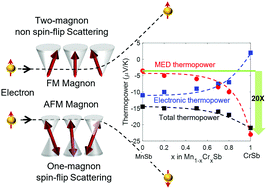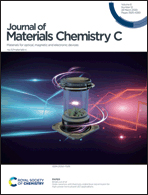Magnon-drag thermopower in antiferromagnets versus ferromagnets†
Abstract
The extension of magnon electron drag (MED) to the paramagnetic domain has recently shown that it can create a thermopower more significant than the classical diffusion thermopower resulting in a thermoelectric figure-of-merit greater than unity. Due to their distinct nature, ferromagnetic (FM) and antiferromagnetic (AFM) magnons interact differently with the carriers and generate different amounts of drag-thermopower. The question arises of whether the MED is stronger in FM or in AFM semiconductors. Two material systems, namely MnSb and CrSb, which are similar in many aspects except that the former is FM and the latter AFM, were studied in detail, and their MED properties were compared. Three features of AFMs compared to FMs, namely double degeneracy of the magnon modes, higher magnon group velocity, and longer magnon relaxation time, can lead to enhanced first-order MED thermopower. One effect, magnon–electron relaxation, leads to a higher second-order effect in AFMs that reduces the MED thermopower. However, it is generally expected that the first-order effect dominates and leads to a higher drag thermopower in AFMs, as seen in this case study.



 Please wait while we load your content...
Please wait while we load your content...